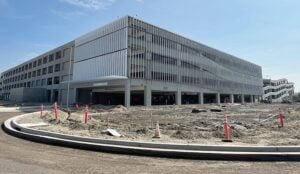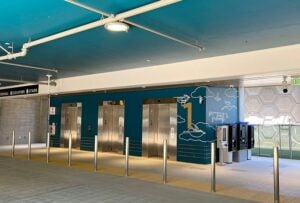The first phase of the new 5-level Terminal 1 Parking Plaza at the San Diego International Airport began operations in August
By Michael Pendergrass
In late August, phase 1 of the 5-level Terminal 1 (T1) Parking Plaza at the San Diego International Airport opened to the public. Comprising more than 2,800 stalls, the new facility includes advanced technology to enhance the parking experience for users, a carefully designed configuration that expedites traffic flows in and out of the garage, as well as an innovative stormwater management system and other sustainable features.
Response to growth

PHOTOS COURTESY OF WATRY DESIGN
Since its construction in 1967, San Diego International Airport’s Terminal 1 has grown from serving 2.5 million passengers to more than 12 million. In response to this growth, the San Diego County Regional Airport Authority — the independent agency that manages the airport’s day-to-day operations — is transforming T1 with an entirely new facility that will offer more gates, a new passenger concourse, an improved roadway system, and a new parking plaza with more than 5,000 parking stalls. When completed, the 5-level T1 Parking Plaza will span 2 million square feet.
Because an existing roadway passes through the footprint for the new parking facility, a new road needed to be constructed before the existing one could be demolished. This necessity, combined with other construction logistics associated with the T1 replacement, meant that only the western half of the parking facility site would be available for construction initially. Therefore, the parking plaza was designed to be delivered in two phases. The recently completed phase 1 is a fully functioning facility that does not depend on features, systems, or elements of phase 2, which will add an additional 2,398 stalls.
Phase 1 was delivered by means of the design-build approach. The construction company Swinerton, Inc., was the design-builder, with the architecture firm Gensler as the design architect. The parking design company Watry Design, Inc., served as the architect and structural engineer of record for the project.
Key design details
In keeping with its goal to offer travelers an exceptional parking experience, the authority enables passengers to reserve parking in advance via the airport’s website. Sustainable-minded customers can purchase a carbon offset along with parking, with each $5 purchase offsetting 1,000 miles of flying.

passengers remember where they parked.
PHOTOS COURTESY OF WATRY DESIGN
T1 Parking Plaza incorporates an elevated technology experience that provides real-time parking information that helps guide users to an available space. Upon a visitor’s arrival, a license plate recognition system recognizes the vehicles of passengers who reserved parking in advance. Alternatively, passengers can use a QR code to gain entry. Passengers who did not reserve a space can go ticketless by scanning a credit card on entry and using the same card when exiting. Pay-on-foot kiosks are also available near the elevators.
Passengers looking to park have flights to catch and ticketing and security lines to navigate. Therefore, an important design consideration entailed expediting traffic flow in and out of the structure. To keep traffic moving smoothly, drivers enter and navigate through the structure by means of a series of cascading speed ramps that circulate cars quickly through the structure. A separate speed ramp directs exiting vehicles out of the structure, mitigating congestion between arriving and exiting drivers. Drive aisles are also oriented from north to south, creating a natural separation between vehicles entering from the north and pedestrians heading south toward the terminal.
Sensors over each parking space inform dynamic signage that displays real-time parking availability at each level and aisle by aisle. Once drivers turn down a parking aisle, LED lights help identify empty spaces. This system enables travelers to swiftly find a parking space without endless circling and idling.
Once on foot in the parking facility, passengers are drawn by expansive lightwells to the elevators and guided to the terminal across the street. During the day, the lightwells draw natural light and ventilation into the large structure. The lightwells include landscaped plazas that feature catenary lighting to create a lively atmosphere in the evenings.
Additional amenities such as vending machines and luggage carts are also available. When drivers depart, tire inflation stations are available free of charge to those
in need.
Going for gold
In certain key ways, the design of the T1 Parking Plaza borrowed from that of its successful predecessor, the Terminal 2 Parking Plaza, which opened in 2018. For example, the Terminal 2 Parking Plaza includes an innovative stormwater management system that collects and reuses rainwater from the facility's roof. To this end, a 100,000-gallon underground storage system collects the rainwater, while a treatment system beneath the bottom level of the structure cleanses and sends the water to the airport’s central utility plant.

PHOTOS COURTESY OF WATRY DESIGN
Each day, the central utility plant uses nearly 30,000 gallons of water to manage the temperature in the airport terminals. Thanks to its stormwater management system, the airport reuses nearly 2 million gallons of rainwater annually to feed the central utility plant, decreasing the volume of potable water that must be used for this purpose.
The T1 Parking Plaza incorporates a similar, but much larger, system for capturing, treating, and reusing roof runoff. Such a system is currently in operation as part of phase 1, while a similar system to be added as part of phase 2 will connect to it once it is complete next year. In total, this combined system will have the capacity to capture, treat, and reuse more than 39 million gallons of roof runoff annually.
In other sustainable design features, the new parking plaza will have more than 30 electric vehicle (EV) charging ports as of fall 2024. Upon full build out, 5% of the total parking stalls will provide EV charging, while another 5% of stalls will be capable of offering it in the future. EV owners can pay for charging at designated payment stations or via app. More than 500 stalls are reserved for EVs and other clean vehicles, those that use alternative fuels, and those that are used for carpools.
These and other sustainable features, including drought tolerant landscaping and efficient lighting, will contribute to efforts to have the overall project certified as a Parksmart Gold level facility as part of the Parksmart program for certifying high-performing, sustainable garages.
Looking ahead
The second phase of the T1 Parking Plaza is scheduled for completion in summer 2025, in time for the opening of 19 new gates as part of the terminal's redevelopment. The companies responsible for the design and construction of phase 1 are handling these same duties for phase 2.
“The opening of the first stage of the New T1 Parking Plaza represents more than just a milestone of the New T1 project, it represents significant progress toward providing our binational region with the air transportation infrastructure it needs and deserves,” said Gil Cabrera, the chair of the San Diego County Regional Airport Authority Board. “We can't wait to come back in the late summer of 2025 and cut the ribbon on the New T1.”
Michael Pendergrass is a principal at Watry Design, Inc. He can be reached at mpendergrass@watrydesign.com.
Project Credits
Owner: San Diego County Regional Airport Authority Board
Design-build contractor: Swinerton, Inc.
Architect and structural engineer of record: Watry Design, Inc.
Design architect: Gensler
Civil engineer: Latitude 33
















